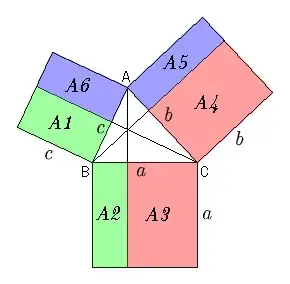This question is based on the diagram

taken from this link. I don't understand why the areas of A6 and A5 adds up to $2bc\cos(A)$.
This question is based on the diagram

taken from this link. I don't understand why the areas of A6 and A5 adds up to $2bc\cos(A)$.
The other side of A6 has length $c \cos A$ and that of A5 length $b \cos A.$
So their total area is $b \times c \cos A + c \times b \cos A = 2bc \cos A.$
If you look at A5. It is a rectangle with side $b$ and, say, $x$. Now $\cos A= x/c$, so $x=c\cos A$. Hence the area of A5 is $bx=bc\cos A$.
A similar argument tells you that the area of A6 is $cb\cos A$.